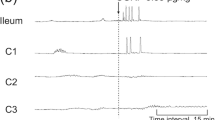Abstract
Increased esophageal blood flow may protect against damaging refluxed gastric juices. We have shown that mast cells, histamine, and nitric oxide increase esophageal blood flow in the opossum during acid perfusion. This study examined the roles of substance P and calcitonin gene-related peptide on acid-induced hyperemia and whether the effects of substance P are mediated by mast cells. The opossum distal esophagus was perfused with saline, acid, or capsaicin while blood flow and histamine release were determined. Neuropeptides and neurokinin antagonists were administered parenterally. Only acid or calcitonin gene-related peptide (not substance P or capsaicin) significantly increased blood flow, which was prevented by neurokinin or calcitonin-gene-related peptide antagonists. Acid, substance P, and capsaicin all increased histamine release. Pretreatment with neurokinin antagonists did not affect acid-induced histamine release. We conclude that calcitonin-gene-related peptide is an important mediator of acid-induced esophageal hyperemia, while substance P plays an indirect role.
Similar content being viewed by others
References
Morris GP, Feldman MJ, Barclay RL, Paterson WG: Esophagitis as the outcome of progressive failures of the defensive repertoire. Can J Gastroenterol 11(suppl B):28B–36B, 1997
Feldman MJ, Morris GP, Dinda PK, Paterson WG: Mast cells mediate acid-induced augmentation of opossum esophageal blood flow. Gastroenterology 110:121–128, 1996
Trad KS, Fernicola MT, Hakki FZ, Dziki AJ, Harmon JW, Bass BL: Modulation of esophageal blood flow: A local effector function of sensory nerves. Surg Forum 41:122–124, 1990
Sandler AD, Schmidt C, Richardson K, Murray J, Maher JW: Regulation of distal esophageal blood flow: The roles of nitric oxide and substance P. Surgery 114:285–294, 1993
McKie LD, Bass BL, Dunkin BJ, Harmon JW: Nitric oxide regulates basal but not capsaicin-, CGRP-, or bile saltstimulated rabbit esophageal mucosal blood flow. Ann Surg 222:186–192, 1995
McKie LD, Dunkin BJ, Pennannen MF, Dunlap KW, Harmon JW, Bass BL: Esophageal mucosal blood flow: A central role for calcitonin gene-related peptide. Surgery 16:409–418, 1994
Fox P, Fox C, Wolfe S Jr, Cooke HJ: Signalling from the nervous system to the immune system occurs via NK1 receptor occupancy of the mast cell. Gastroenterology 110:A1071, 1996
Geppetti P, Tramontana M, Evangelista S, Renzi D, Maggi CA, Fusco BM, Del Bianco E: Differential effect on neuropeptide release of different concentrations of hydrogen ions on afferent and intrinsic neurons of the rat stomach. Gastroenterology 101:1505–1511, 1991
Ren JY, Wang YP, Liang KX, Gao JS, Brewer K, Harty RF: Mechanisms of proton-induced stimulation of CGRP release from rat antrum. Regul Pept, 59:103–109, 1995
Blennerhasset MG, Tomioka M, Bienenstock J: Formation of contacts between mast cells and sympathetic neurons in vitro. Cell Tissue Res 265:121–128, 1991
Arizono N, Matsuda S, Hattori T, Kojima Y, Maeda T, Galli SJ: Anatomical variation in mast cell nerve associations in the rat small intestine, heart, lung, and skin. Similarities of distances between neural processes and mast cells, eosinophils, or plasma cells in the jejunal lamina propria. Lab Invest 62:626–634, 1990
Cross LJM, Heaney LG, Ennis M: Further characteristics of substance P induced histamine release from human bronchoalveolage lavage mast cells. Inflamm Res 45:S11–S12, 1996
Lilly CM, Hall AE, Rodger IW, Kobzik L, Haley KJ, Drazen JM: Substance P-induced histamine release in tracheally perfused guinea pig lungs. J Appl Physiol 78:1234–1241, 1995
Brunsson I, Fahrenkrug J, Jodal M, Sjöqvist A, Lundgren O: Substance P effects on blood flow, fluid transport, and vasoactive intestinal polypeptide release in the feline small intestine. J Physiol 483:727–734, 1995
Wallace JL, McKnight GW, Befus AD: Capsaicin-induced hyperemia in the stomach: Possible contribution of mast cells. Am J Physiol (Gastrointest Liver Physiol) 263:G209–G214, 1992
Shore PA, Burkhalter A, Cohn VH: A method for the fluorimetric assay of histamine in tissues. J Pharmacol Exp Ther 127:182–186, 1959
Feldman MJ, White RJ, Morris GP, Paterson WG: Low dose pepsin blocks acid-induced hyperemia in the opossum esophagus. Can J Gastroenterol 12(suppl A):115A, 1998
Rival R, Bance M, Antonyshyn O, Phillips J, Pang CY: Comparison of laser Doppler flowmeter and radioactive microspheres in measuring blood flow in pig skin flaps. Laryngoscope 105:383–386, 1995
Zijlstra PK, Hynna-Liepert TT, Dinda PK, Beck IT, Paterson WG: The effect of intraluminal acid on opossum esophageal blood flow. Gastroenterology 98:A155, 1990
Ottosson A, Edvinsson L: Release of histamine from dural mast cells by substance P and calcitonin gene-related peptide. Cephalalgia 17:166–174, 1997
Krumins SA, Broomfield CA: Evidence of NK1 and NK2 tachykinin receptors and their involvement in histamine release in a murine mast cell line. Neuropeptides 21:65–72, 1992
Cocchiara R, Bongiovanni A, Albeggiani G, Azzolina A, Lampiasi N, Di Blasi F, Geraci D: Inhibitory effect of neuraminidase on SP-induced histamine release and TNF-alpha mRNA in rat mast cells: evidence of a receptor-independent mechanism. J Neuroimmunol 75:9–18, 1997
Reymer-Rebuffel AM, Mathiau P, Callebert J, Dimitriadou V, Farjaudon N, Kacem K, Launay JM, Seylaz J, Abineau P: Substance P, calcitonin gene-related peptide, and capsaicin release serotonin from cerebrovascular mast cells. Am J Physiol 267:R1421–1429, 1994
Author information
Authors and Affiliations
Rights and permissions
About this article
Cite this article
Feldman, M., Morris, G. & Paterson, W. Role of Substance P and Calcitonin Gene-Related Peptide in Acid-Induced Augmentation of Opossum Esophageal Blood Flow. Dig Dis Sci 46, 1194–1199 (2001). https://doi.org/10.1023/A:1010646809166
Issue Date:
DOI: https://doi.org/10.1023/A:1010646809166




